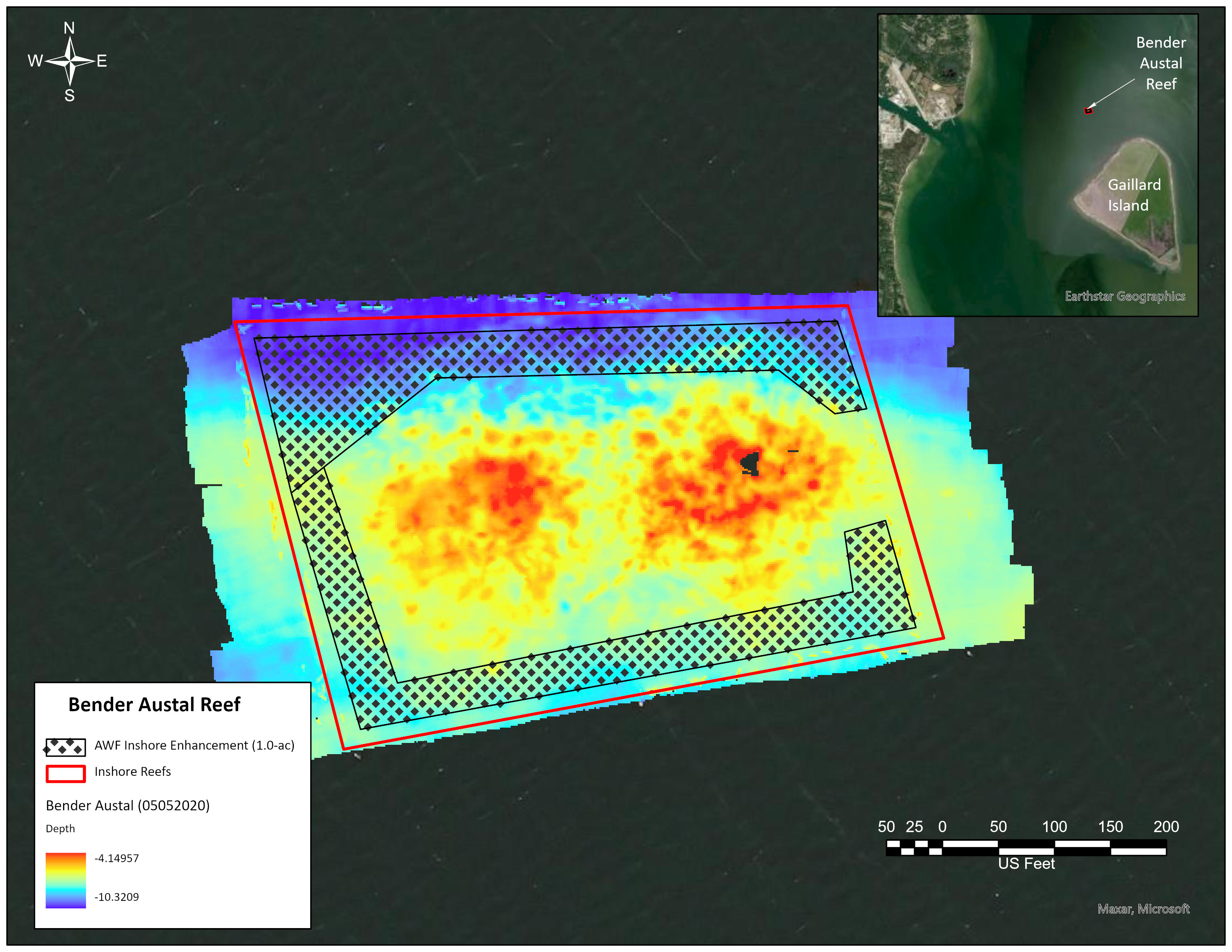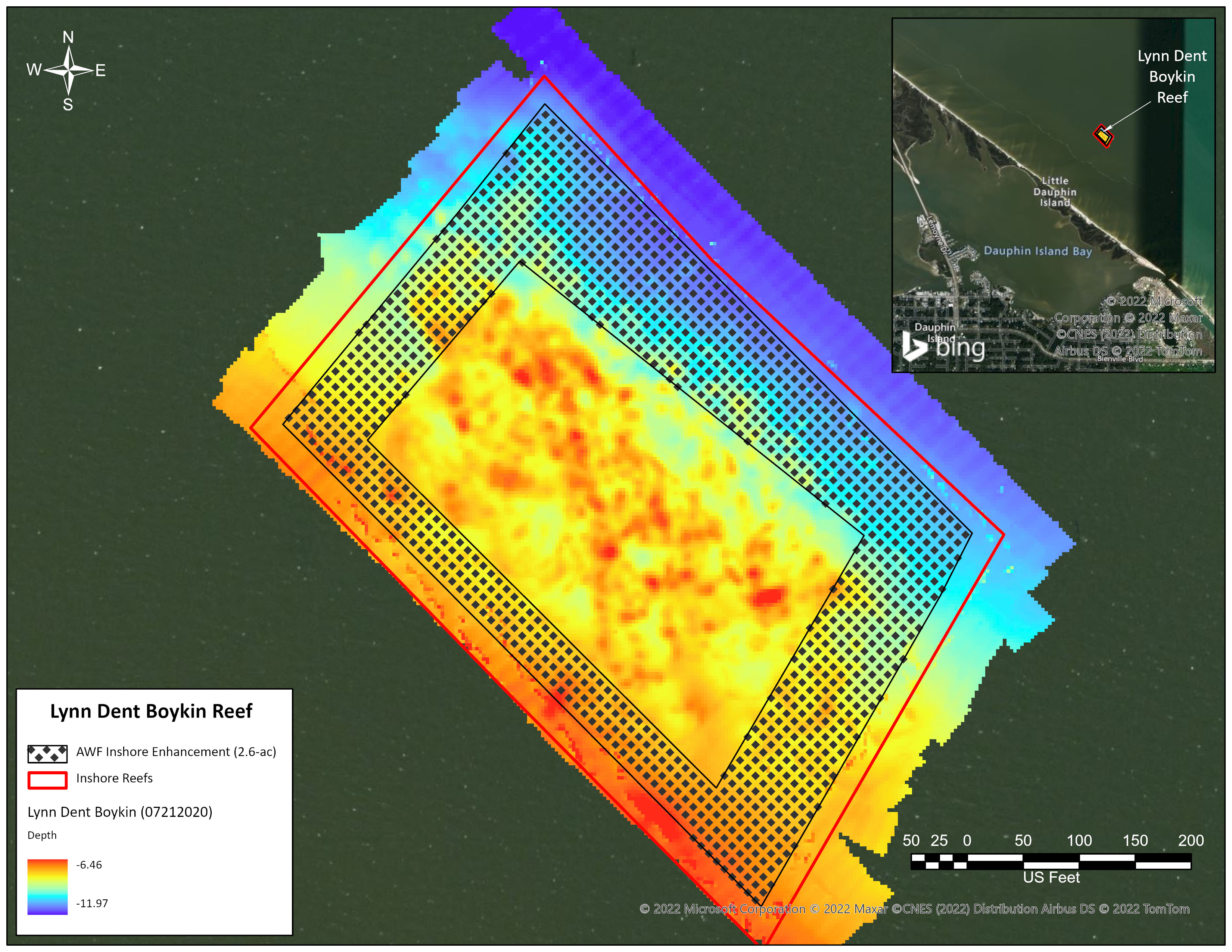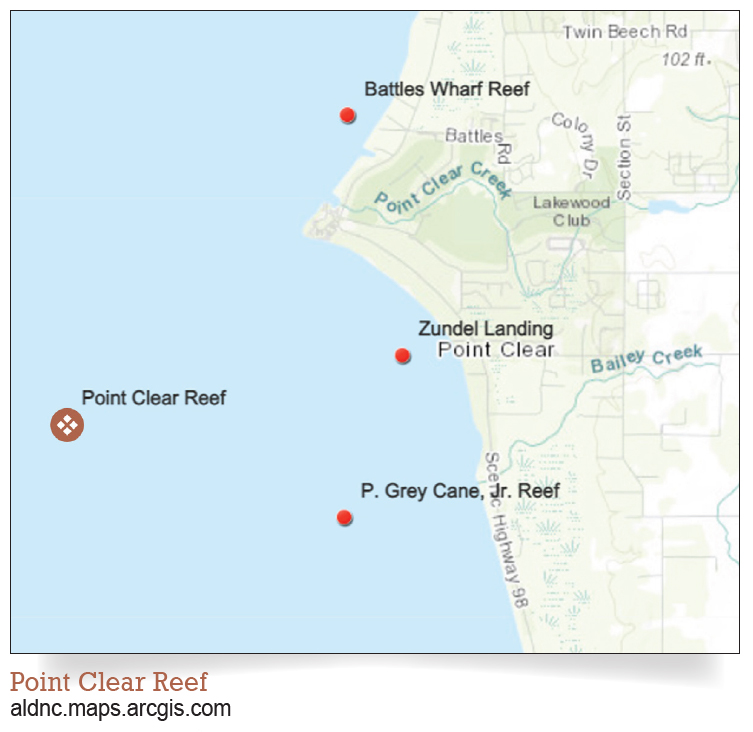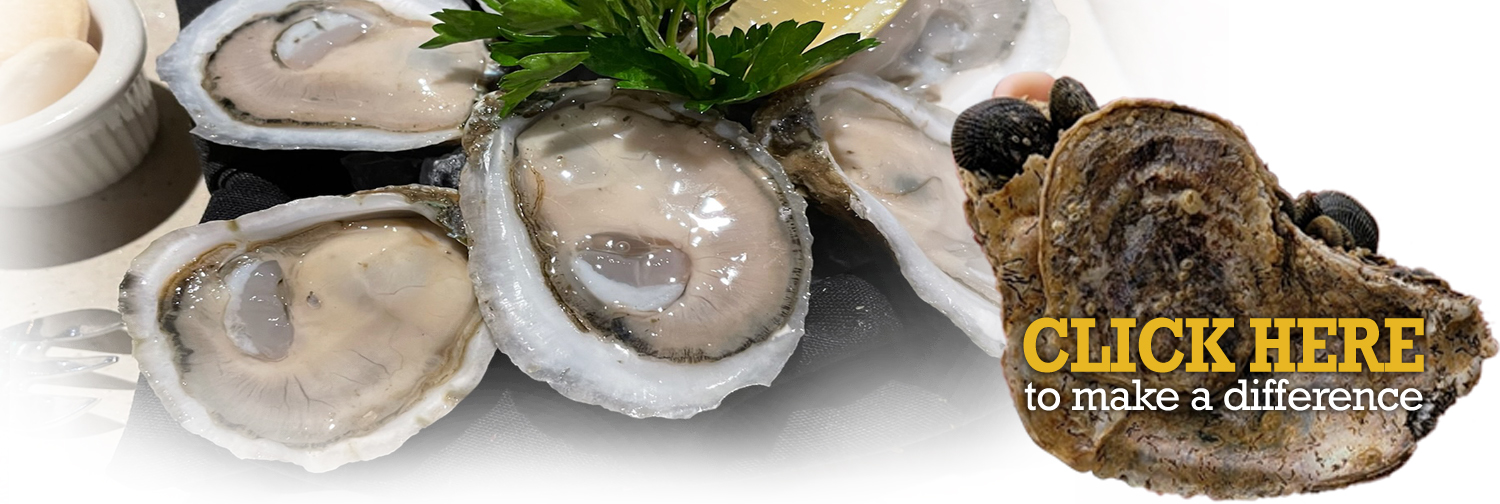AWF Oyster Restoration Fund
IF YOU CARE about clean water, quality marine habitat, great inshore fishing reefs, and the world-class taste of Alabama oysters on the half-shell, you can contribute to the AWF OYSTER RESTORATION FUND, make a difference, and directly impact oyster restoration in Alabama.
AWF Launches Oyster Restoration Initiative with Quarter-Million Investment
ALABAMA WILDLIFE OYSTER RESTORATION ARTICLE - FALL 2022 (PDF)
THE PLAN
Oysters have been a part of Alabama’s culture for over 12 centuries, from both an ecological and economic standpoint. They are critically important to water quality, marine habitat, and shoreline protection in Alabama’s Mobile Bay and Mississippi Sound. In spite of that history and importance, Alabama’s oyster populations have been declining, due to a variety of reasons, since the 1950s.
Alabama Wildlife Federation (AWF) has worked with the Alabama Marine Resources Division (AMRD), who put together the “Coastal Alabama Comprehensive Oyster Restoration Strategy,” to help address the oyster decline. Specifically, we have worked to pinpoint restoration activities that AWF can implement, with the help of our members and supporters, to have a significant impact on oyster restoration. Our focus is to create new oyster reefs, restore or enhance existing reefs, and improve the connectivity between reefs. These three oyster restoration strategies will help build a more resilient oyster population in Mobile Bay and Mississippi Sound that improves water quality, enhances marine habitat, and supports sustainable oyster harvests for generations to come.
TAKING ACTION
In February, 2022, the AWF Oyster Restoration Committee recommended, and the AWF Board of Directors approved, setting aside a quarter of a million dollars for oyster restoration in Mobile Bay and Mississippi Sound. From February through August, the AWF Oyster Restoration Committee worked closely with AMRD staff to identify specific restoration projects for implementation. In August, 2022, the AWF Oyster Restoration Committee recommended, and the AWF Board approved putting those funds to work through three specific projects: BENDER AUSTAL REEF ENLARGEMENT
BENDER AUSTAL REEF ENLARGEMENT
The Bender Austal Reef (Figure 1) is located on the western shore of Mobile Bay just northwest of Gaillard Island. This reef is located in the upper end of the western shore zone where water conditions (salinity, dissolved oxygen, etc.) are favorable for oyster development. Recent surveys of this area have shown signs of oyster development, but increasing the available cultch material (material on which oysters can attach and grow) is needed to help advance oyster restoration. With a successful oyster population increase at that site, the quantity of oyster larvae available to circulate up and down the western shore will improve and benefit the productivity of both existing and new oyster reefs. The Bender Austal Reef Enlargement will add 1,000 tons of three to six-inch limestone aggregate (cultch material) over a one-acre footprint at a cost of $70,000. The project will provide new oyster and marine habitat, including enhanced inshore fishing structure.
LYNN DENT BOYKIN REEF ENLARGEMENT
 The Lynn Dent Boykin Reef (Figure 2) is located on the western shore of Mobile Bay near Dauphin Island. This reef is located in the lower end of the western shore zone where water conditions are favorable for oyster development. Like Bender Austal Reef, recent surveys have confirmed oyster development at the site. Additional cultch material at the Lynn Dent Boykin Reef will help increase oyster populations, oyster larvae, and larval exchange between existing and new reefs along the western shore.
The Lynn Dent Boykin Reef (Figure 2) is located on the western shore of Mobile Bay near Dauphin Island. This reef is located in the lower end of the western shore zone where water conditions are favorable for oyster development. Like Bender Austal Reef, recent surveys have confirmed oyster development at the site. Additional cultch material at the Lynn Dent Boykin Reef will help increase oyster populations, oyster larvae, and larval exchange between existing and new reefs along the western shore.
The Lynn Dent Boykin Reef will add 2,600 tons of three to six-inch limestone aggregate (cultch material) over a 2.6-acre footprint at a cost of $182,000. The project will provide new oyster and marine habitat, including enhanced inshore fishing structure.
 POINT CLEAR REEF SONDE UNIT
POINT CLEAR REEF SONDE UNIT
The Point Clear Reef (Figure 3) is located on the eastern shore of Mobile Bay near Point Clear. Within Mobile Bay, the western shore has the largest extent of favorable water, or habitat, conditions for oyster development. Along the eastern shore, water conditions suitable for oysters is less consistent. To most effectively deploy oyster restoration strategies on the eastern shore, we need to identify the areas with the best water conditions for oyster development. The Point Clear Reef is an area where oysters have existed in the past, but more info is needed on current water conditions. A multi-parameter SONDE unit is a device used to monitor a variety of water conditions over time. Most importantly from an oyster habitat standpoint, the SONDE unit will be used to measure water temperature, salinity, pH, turbidity, and dissolved oxygen. Since Mobile Bay is a living and dynamic system, water conditions never remain the same. They fluctuate based on inflow from the rivers that feed into the Bay, tides, time of year, etc. For that reason, the SONDE unit will be deployed and measure water conditions over a twelve-month period. The results of the monitoring will help inform the decision on future oyster restoration activities at the Point Clear Reef. Estimated cost for the SONDE unit is approximately $25,000 - $30,000.
The AWF Oyster Restoration Fund - A Catalyst Fund for Startup and Expansion
AWF took the bold step back in February, 2022 to set aside a quarter of a million dollars into the AWF Oyster Restoration Fund before we even identified our first projects. This decision reflects AWF’s understanding of the importance of oyster restoration in Alabama’s Mobile Bay and Mississippi Sound as well as the magnitude of the financial investment necessary to make meaningful progress with oyster restoration. The Bender Austal, Lynn Dent Boykin, and Point Clear Reef projects are just the beginning. AWF is already reviewing other relic oyster reef sites with AMRD to identify additional projects.
Our goal is to use this first investment by AWF as a catalyst for oyster restoration startup and continuous expansion with the support of AWF members, supporters, and all who value robust and productive oyster reefs and populations in Alabama’s coastal waters. FIRST FRUITS
The catalyst effect of the AWF Oyster Restoration Fund has already yielded fruit. Within one week of the AWF Board’s approval to move forward with the Bender Austal, Lynn Dent Boykin, and Point Clear Reef projects, 50% of the funds necessary to complete the Bender Austal Reef was secured. Special thanks to a dozen AWF members and Alabama Power Company for teaming up on the Bender Austal Reef. On top of that, every member of the AWF Oyster Restoration Committee has committed personal donations to help build the fund. This is just the beginning and great first fruits.
Our overall goal for the Bender Austal, Lynn Dent Boykin, and Point Clear Reef projects is to cover 50% of the cost with AWF funds and 50% from raised funds. With the Bender Austal funding secured at that 50/50 level, the Lynn Dent Boykin Reef is next on the list. Our goal is to secure four funding partners at $25,000 each to sponsor a portion of the reef enlargement cost. When that happens, just as with the Bender Austal Reef, those funds allow a portion of AWF’s initial investment to roll back into the fund and provide the catalyst, start-up funding for the next project. Add to that general support from AWF members, supporters, and those who simply want to see Alabama oysters thrive, through donations to the AWF Oyster Restoration Fund, and will be well on our way to starting the next oyster restoration project.
Every time you eat an oyster on the half-shell, fish on an inshore fishing reef, or look out on Mobile Bay and appreciate the value of clean water, take action and donate to the AWF Oyster Restoration Fund. Collectively, we can have a big impact on oyster restoration in Alabama.
 .
.
AWF Launches Oyster Restoration Initiative with Quarter-Million Investment
ALABAMA WILDLIFE OYSTER RESTORATION ARTICLE - FALL 2022 (PDF)
THE PLAN
Oysters have been a part of Alabama’s culture for over 12 centuries, from both an ecological and economic standpoint. They are critically important to water quality, marine habitat, and shoreline protection in Alabama’s Mobile Bay and Mississippi Sound. In spite of that history and importance, Alabama’s oyster populations have been declining, due to a variety of reasons, since the 1950s.
Alabama Wildlife Federation (AWF) has worked with the Alabama Marine Resources Division (AMRD), who put together the “Coastal Alabama Comprehensive Oyster Restoration Strategy,” to help address the oyster decline. Specifically, we have worked to pinpoint restoration activities that AWF can implement, with the help of our members and supporters, to have a significant impact on oyster restoration. Our focus is to create new oyster reefs, restore or enhance existing reefs, and improve the connectivity between reefs. These three oyster restoration strategies will help build a more resilient oyster population in Mobile Bay and Mississippi Sound that improves water quality, enhances marine habitat, and supports sustainable oyster harvests for generations to come.
TAKING ACTION
In February, 2022, the AWF Oyster Restoration Committee recommended, and the AWF Board of Directors approved, setting aside a quarter of a million dollars for oyster restoration in Mobile Bay and Mississippi Sound. From February through August, the AWF Oyster Restoration Committee worked closely with AMRD staff to identify specific restoration projects for implementation. In August, 2022, the AWF Oyster Restoration Committee recommended, and the AWF Board approved putting those funds to work through three specific projects:
- Enlargement of the Bender Austal Reef on the western shore of Mobile Bay
- Enlargement of the Lynn Dent Boykin Reef on the western shore of Mobile Bay
- Deployment of a SONDE unit to evaluate oyster habitat suitability at the Point Clear Reef on the eastern shore of Mobile Bay
 BENDER AUSTAL REEF ENLARGEMENT
BENDER AUSTAL REEF ENLARGEMENTThe Bender Austal Reef (Figure 1) is located on the western shore of Mobile Bay just northwest of Gaillard Island. This reef is located in the upper end of the western shore zone where water conditions (salinity, dissolved oxygen, etc.) are favorable for oyster development. Recent surveys of this area have shown signs of oyster development, but increasing the available cultch material (material on which oysters can attach and grow) is needed to help advance oyster restoration. With a successful oyster population increase at that site, the quantity of oyster larvae available to circulate up and down the western shore will improve and benefit the productivity of both existing and new oyster reefs. The Bender Austal Reef Enlargement will add 1,000 tons of three to six-inch limestone aggregate (cultch material) over a one-acre footprint at a cost of $70,000. The project will provide new oyster and marine habitat, including enhanced inshore fishing structure.
LYNN DENT BOYKIN REEF ENLARGEMENT
 The Lynn Dent Boykin Reef (Figure 2) is located on the western shore of Mobile Bay near Dauphin Island. This reef is located in the lower end of the western shore zone where water conditions are favorable for oyster development. Like Bender Austal Reef, recent surveys have confirmed oyster development at the site. Additional cultch material at the Lynn Dent Boykin Reef will help increase oyster populations, oyster larvae, and larval exchange between existing and new reefs along the western shore.
The Lynn Dent Boykin Reef (Figure 2) is located on the western shore of Mobile Bay near Dauphin Island. This reef is located in the lower end of the western shore zone where water conditions are favorable for oyster development. Like Bender Austal Reef, recent surveys have confirmed oyster development at the site. Additional cultch material at the Lynn Dent Boykin Reef will help increase oyster populations, oyster larvae, and larval exchange between existing and new reefs along the western shore.The Lynn Dent Boykin Reef will add 2,600 tons of three to six-inch limestone aggregate (cultch material) over a 2.6-acre footprint at a cost of $182,000. The project will provide new oyster and marine habitat, including enhanced inshore fishing structure.
 POINT CLEAR REEF SONDE UNIT
POINT CLEAR REEF SONDE UNITThe Point Clear Reef (Figure 3) is located on the eastern shore of Mobile Bay near Point Clear. Within Mobile Bay, the western shore has the largest extent of favorable water, or habitat, conditions for oyster development. Along the eastern shore, water conditions suitable for oysters is less consistent. To most effectively deploy oyster restoration strategies on the eastern shore, we need to identify the areas with the best water conditions for oyster development. The Point Clear Reef is an area where oysters have existed in the past, but more info is needed on current water conditions. A multi-parameter SONDE unit is a device used to monitor a variety of water conditions over time. Most importantly from an oyster habitat standpoint, the SONDE unit will be used to measure water temperature, salinity, pH, turbidity, and dissolved oxygen. Since Mobile Bay is a living and dynamic system, water conditions never remain the same. They fluctuate based on inflow from the rivers that feed into the Bay, tides, time of year, etc. For that reason, the SONDE unit will be deployed and measure water conditions over a twelve-month period. The results of the monitoring will help inform the decision on future oyster restoration activities at the Point Clear Reef. Estimated cost for the SONDE unit is approximately $25,000 - $30,000.
The AWF Oyster Restoration Fund - A Catalyst Fund for Startup and Expansion
AWF took the bold step back in February, 2022 to set aside a quarter of a million dollars into the AWF Oyster Restoration Fund before we even identified our first projects. This decision reflects AWF’s understanding of the importance of oyster restoration in Alabama’s Mobile Bay and Mississippi Sound as well as the magnitude of the financial investment necessary to make meaningful progress with oyster restoration. The Bender Austal, Lynn Dent Boykin, and Point Clear Reef projects are just the beginning. AWF is already reviewing other relic oyster reef sites with AMRD to identify additional projects.
Our goal is to use this first investment by AWF as a catalyst for oyster restoration startup and continuous expansion with the support of AWF members, supporters, and all who value robust and productive oyster reefs and populations in Alabama’s coastal waters. FIRST FRUITS
The catalyst effect of the AWF Oyster Restoration Fund has already yielded fruit. Within one week of the AWF Board’s approval to move forward with the Bender Austal, Lynn Dent Boykin, and Point Clear Reef projects, 50% of the funds necessary to complete the Bender Austal Reef was secured. Special thanks to a dozen AWF members and Alabama Power Company for teaming up on the Bender Austal Reef. On top of that, every member of the AWF Oyster Restoration Committee has committed personal donations to help build the fund. This is just the beginning and great first fruits.
Our overall goal for the Bender Austal, Lynn Dent Boykin, and Point Clear Reef projects is to cover 50% of the cost with AWF funds and 50% from raised funds. With the Bender Austal funding secured at that 50/50 level, the Lynn Dent Boykin Reef is next on the list. Our goal is to secure four funding partners at $25,000 each to sponsor a portion of the reef enlargement cost. When that happens, just as with the Bender Austal Reef, those funds allow a portion of AWF’s initial investment to roll back into the fund and provide the catalyst, start-up funding for the next project. Add to that general support from AWF members, supporters, and those who simply want to see Alabama oysters thrive, through donations to the AWF Oyster Restoration Fund, and will be well on our way to starting the next oyster restoration project.
Every time you eat an oyster on the half-shell, fish on an inshore fishing reef, or look out on Mobile Bay and appreciate the value of clean water, take action and donate to the AWF Oyster Restoration Fund. Collectively, we can have a big impact on oyster restoration in Alabama.
 .
.
Quick Links
- Land Stewardship Assistance
- AWF Oyster Restoration Fund
- Native Warm Season Grass Project
- Longleaf Pine Ecosystem Restoration Project
- Gulf Coast Conservation Grants Program Project
- Landowner Network
- NWSG Series Events
- Managing Wildlife Book
- Alabama Wildlife Magazine
- Wildlife Seminars
- Alabama Black Bear Alliance
- Mobile Delta Purchase
- AWF Governors Conservation Achievement Awards
 Wildlife Tag
Wildlife Tag

